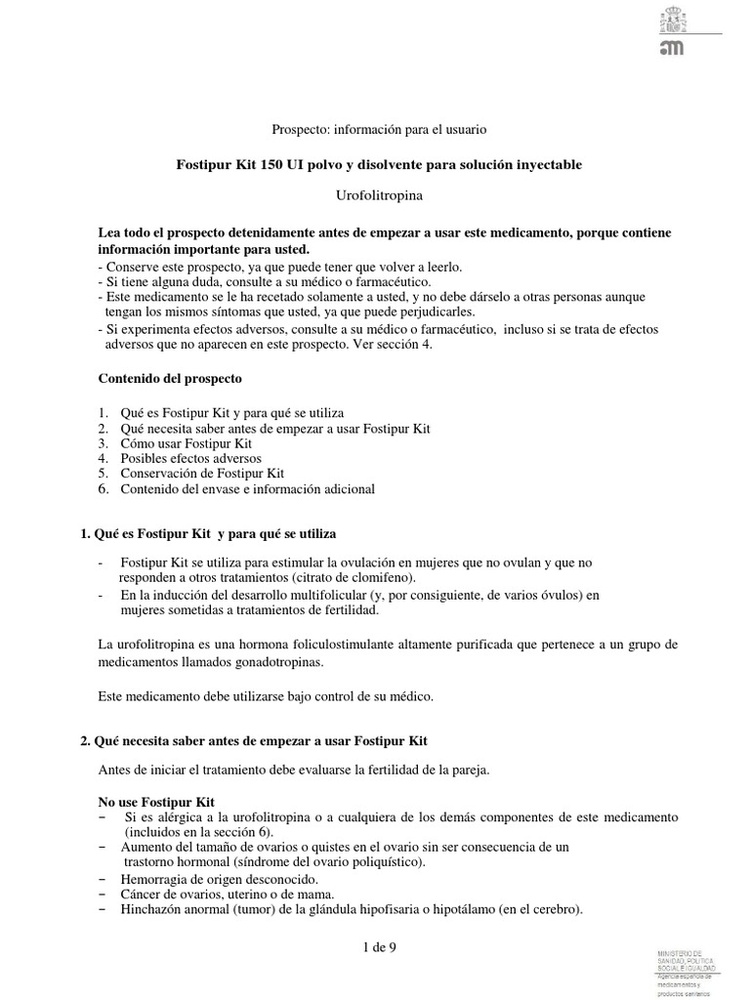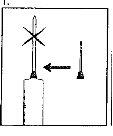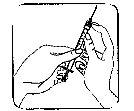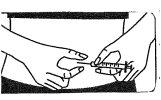

ФОСТИПУР 150 МЕ ПОРОШОК И РАСТВОРИТЕЛЬ ДЛЯ ПРИГОТОВЛЕНИЯ ИНЪЕКЦИОННОГО РАСТВОРА


Инструкция по применению ФОСТИПУР 150 МЕ ПОРОШОК И РАСТВОРИТЕЛЬ ДЛЯ ПРИГОТОВЛЕНИЯ ИНЪЕКЦИОННОГО РАСТВОРА
Введение
Инструкция: информация для пользователя
Фостипур 150 МЕ порошок и растворитель для инъекционного раствора
Урофоллитропин
Прочитайте внимательно всю инструкцию перед началом использования этого лекарства, поскольку она содержит важную информацию для вас.
- Сохраните эту инструкцию, поскольку вам может потребоваться прочитать ее снова.
- Если у вас есть какие-либо вопросы, проконсультируйтесь с вашим врачом или фармацевтом.
- Это лекарство было назначено только вам, и не передавайте его другим людям, даже если у них такие же симптомы, как у вас, поскольку оно может нанести им вред.
- Если вы испытываете побочные эффекты, проконсультируйтесь с вашим врачом или фармацевтом, даже если это побочные эффекты, которые не указаны в этой инструкции. См. раздел 4.
Содержание инструкции
- Что такое Фостипур и для чего он используется
- Что вам нужно знать перед началом использования Фостипура
- Как использовать Фостипур
- Возможные побочные эффекты
- Хранение Фостипура
- Содержание упаковки и дополнительная информация
1. Что такое Фостипур и для чего он используется
- Фостипур используется для стимуляции овуляции у женщин, которые не овулируют и не реагируют на другие методы лечения (цитрат кломифена).
- Для индукции многофолликулярного развития (и, следовательно, нескольких яйцеклеток) у женщин, подвергающихся лечению бесплодия.
Урофоллитропин является высокопурифицированной человеческой фолликулостимулирующей гормоной, которая принадлежит к группе лекарств, называемых гонадотропинами.
Это лекарство должно использоваться под контролем вашего врача.
2. Что вам нужно знать перед началом использования Фостипура
Перед началом лечения необходимо оценить фертильность пары.
Не используйте Фостипур
- Если вы аллергичны к урофоллитропину или любому другому компоненту этого лекарства (указанному в разделе 6).
- Увеличение размера яичников или кисты в яичнике, не являющееся следствием гормонального расстройства (синдром поликистозных яичников).
Кровотечение неизвестного происхождения.
- Рак яичников, матки или молочной железы.
- Аномальное утолщение (опухоль) гипофиза или гипоталамуса (в мозге).
Не используйте это лекарство, если у вас есть расстройства, такие как преждевременная менопауза, аномалии половых органов или опухоли матки, которые могут помешать нормальной беременности.
Предостережения и меры предосторожности
Хотя нет информации о аллергических реакциях на Фостипур, вам следует сообщить врачу, если у вас есть аллергия на подобные лекарства.
Это лечение увеличивает риск развития заболевания, известного как синдром гиперстимуляции яичников (СГЯ) (см. Возможные побочные эффекты). Если возникает гиперстимуляция яичников, необходимо прекратить лечение и избегать беременности. Первые признаки гиперстимуляции яичников - боль в нижней части живота, а также тошнота (дискомфорт), рвота и увеличение веса. Если появляются эти симптомы, необходимо как можно скорее обратиться к врачу. В тяжелых, но редких случаях, яичники могут увеличиться в размере, и может скапливаться жидкость в брюшной полости или груди.
Лекарство, используемое для достижения окончательного освобождения созревших яйцеклеток (содержащее человеческую хорионическую гонадотропину, хГЧ), может увеличить вероятность развития СГЯ. Поэтому не рекомендуется использовать хГЧ в случаях, когда развивается гиперстимуляция яичников, и также не следует вступать в половые контакты, даже используя барьерные методы контрацепции, в течение минимум 4 дней.
Следует учитывать, что женщины с проблемами фертильности имеют более высокий уровень спонтанных абортов по сравнению с общей популяцией.
Риск многоплодной беременности и рождения у пациенток, получающих лечение для индукции овуляции, увеличивается по сравнению с естественным зачатием. Однако этот риск можно снизить, если использовать рекомендуемую дозу.
Существует небольшой риск внематочной беременности у женщин с поврежденными фаллопиевыми трубами.
Многоплодная беременность и характеристики родителей, подвергающихся лечению бесплодия (например, возраст матери, характеристики спермы), могут быть связаны с более высоким риском аномалий при рождении.
Лечение Фостипуром, как и сама беременность, может увеличить риск развития тромбоза. Тромбоз - это образование сгустка крови в кровеносном сосуде, чаще всего в венах ног или легких.
Проконсультируйтесь с вашим врачом перед началом лечения, особенно:
- если вы уже знаете, что у вас более высокий риск развития тромбоза,
- если вы или близкий родственник когда-либо страдали тромбозом,
- если у вас есть избыточный вес.
Это лекарство приготовлено из мочи человека. Риск передачи инфекции или заболевания в организм нельзя полностью исключить. Однако этот риск ограничен стадиями удаления вирусов в процессе производства, в частности ВИЧ, вируса герпесаи папилломавируса.
Не было зарегистрировано случаев вирусной контаминации.
Использование Фостипура с другими лекарствами
Сообщите врачу или фармацевту, если вы используете, недавно использовали или можете использовать любое другое лекарство.
Беременность и лактация
Фостипур не должен использоваться, если вы беременны или кормите грудью.
Фостипур содержит натрий
Это лекарство содержит менее 1 ммоль натрия (23 мг) на дозу, что означает, что оно практически не содержит натрия.
3. Как использовать Фостипур
Дозировка и продолжительность лечения:
Следуйте точно инструкциям по применению этого препарата, указанным вашим врачом. В случае сомнений проконсультируйтесь снова с вашим врачом или фармацевтом.
Женщины, которые не овулируют и имеют нерегулярные или неполные менструации:
Если у вас есть менструация, лечение должно начинаться в течение 7 дней после начала менструации (первые 7 дней менструального цикла).
Дозировка состоит из 1 инъекции в день, под кожу (подкожно) или в мышцу (внутримышечно).
Обычная начальная доза составляет 75 МЕ до 150 МЕ ФСГ (Фостипур) в день. Эта доза может быть увеличена, если необходимо, на 37,5 до 75 МЕ с интервалом 7 дней или, предпочтительно, 14 дней, для получения адекватного ответа.
Максимальная суточная доза ФСГ обычно не должна превышать 225 МЕ.
Если ваш врач не обнаруживает адекватного ответа после 4 недель лечения, этот цикл лечения должен быть прерван. Для следующего цикла ваш врач назначит лечение с более высокой начальной дозой.
Когда получен хороший ответ (удовлетворительный фолликулярный рост), будет введена только одна инъекция другого препарата (хГЧ), используемого для индукции фолликулярной зрелости и овуляции. Это произойдет через 24-48 часов после последней инъекции Фостипура. Рекомендуется иметь половые контакты в день введения хГЧ и на следующий день.
Если получен чрезмерный овариальный ответ, лечение должно быть прервано, и хГЧ не будет введен (см. Возможные побочные эффекты). Для следующего цикла ваш врач назначит более низкую начальную дозу.
Женщины, подвергающиеся овариальной стимуляции для множественного фолликулярного развития перед экстракорпоральным оплодотворением или другими методами вспомогательной репродукции:
Ситуация 1 – Если у вас есть менструация.
Лечение должно начинаться на 2-3 день после начала менструации (первые 2-3 дня менструального цикла).
Дозировка состоит из 1 инъекции в день подкожно или внутримышечно.
Обычно используемая доза для суперовуляции состоит в введении 150-225 МЕ Фостипура в день. Лечение продолжается с коррекцией дозы в зависимости от ответа, пока не будет достигнут удовлетворительный фолликулярный рост. Это обычно происходит на 10-й день лечения (в среднем 5-20 дней) и оценивается путем взятия крови и/или ультразвукового исследования.
Максимальная доза обычно составляет 450 МЕ/день.
После достижения фолликулярного роста будет введена одна инъекция препарата, используемого для индукции окончательной фолликулярной зрелости; этот препарат содержит до 10 000 МЕ хорионического гонадотропина человека (хГЧ). Он будет введен через 24-48 часов после последней инъекции Фостипура.
Пункция фолликулов будет проведена примерно через 35 часов позже.
Ситуация 2 – Когда используется агонист гонадотропин-рилизинг-гормона (ГнРГ).
Фостипур должен быть введен примерно через 2 недели после начала этого лечения. Оба лечения продолжаются до достижения удовлетворительного фолликулярного роста. Будет введена одна инъекция Фостипура в день внутримышечно или подкожно. Например, после 2 недель лечения агонистом ГнРГ будут введены 150-225 МЕ Фостипура в течение первых 7 дней. Доза затем будет корректироваться в зависимости от овариального ответа.
Инструкции по введению:
Фостипур вводится путем инъекции как под кожу (подкожно), так и в мышцу (внутримышечно).
Каждая ампула предназначена для одноразового использования, и инъекция должна быть введена сразу после подготовки.
После консультации и практики ваш врач может попросить вас сами вводить себе инъекцию Фостипура.
Прежде всего, ваш врач должен:
- Позволить вам практиковать введение инъекции подкожно.
- Указать вам возможные места для введения инъекции.
- Показать вам, как тщательно подготовить раствор для инъекции.
- Объяснить вам, как подготовить правильную дозу для введения.
Другие формы выпуска, отличные от ампул, предназначены для самоинъекции пациентками.
Прежде чем вы введете себе инъекцию Фостипура, внимательно прочитайте следующие инструкции:
Как подготовить и ввести Фостипур, используя 1 ампулу с порошком
Раствор должен быть подготовлен прямо перед введением инъекции. Каждая ампула используется для одноразового применения. Препарат должен быть восстановлен в асептических условиях.
Фостипур должен быть восстановлен только с помощью растворителя, предоставленного в упаковке.
Подготовьте чистую поверхность и вымойте руки перед восстановлением раствора. Важно, чтобы ваши руки и инструменты, которые вы будете использовать, были как можно более чистыми.
Разложите следующие материалы на чистой поверхности:
- 2 кусочка ваты с алкоголем (не входят в комплект)
- 1 ампула, содержащая порошок Фостипура
- 1 ампула растворителя
- 1 шприц (не входит в комплект)
- 1 игла для подготовки инъекции (не входит в комплект)
- 1 тонкая игла для подкожной инъекции (не входит в комплект)
Восстановление раствора для инъекции, используя 1 ампулу с порошком
Подготовка раствора для инъекции:
| 1. Верхняя часть ампулы специально разработана для легкого разрыва ниже окрашенной точки. Аккуратно встряхните верхнюю часть ампулы, чтобы удалить любой оставшийся жидкости из кончика. Держите ампулу с окрашенной точкой, обращенной наружу, и удалите верхнюю часть ампулы, как показано на изображении. Использование ткани или разрывателя ампул поможет защитить ваши пальцы. Аккуратно положите открытую ампулу на чистую поверхность. |
| 2. Удалите защитный колпачок с иглы. Прикрепите иглу для восстановления (большую иглу) к шприцу. Держите шприц в одной руке, возьмите открытую ампулу растворителя, вставьте иглу и извлеките весь растворитель в шприц. Наденьте защитный колпачок на иглу. Аккуратно положите шприц на поверхность. |
| 3. Удалите пластиковый колпачок с ампулы порошка, слегка надавив вверх. Дезинфицируйте верхнюю часть резиновой пробки ватой с алкоголем и дайте ей высохнуть. |
| 4. Возьмите шприц, удалите защитный колпачок с иглы и медленно введите растворитель через центральную верхнюю часть резиновой пробки ампулы порошка. Надавите на поршеньfirmly вниз, чтобы выпустить весь раствор на порошок. НЕ ВСТРАХИВАЙТЕ, но слегка перемешайте ампулу между руками, пока порошок не будет полностью растворен, пытаясь избежать образования пены. |
| 5. Как только порошок будет полностью растворен (что обычно происходит сразу), медленно извлеките раствор в шприц.
|
Подготовка более высоких доз, используя более 1 ампулы с порошком.
Если ваш врач назначил более высокие дозы, вы можете добиться этого, используя более 1 ампулы с порошком с ампулой растворителя.
Когда восстанавливается более 1 ампулы Фостипура, в конце фазы 4, описанной выше, введите содержимое восстановленной ампулы обратно в шприц и медленно введите его во вторую ампулу. Повторите фазы 2-4 для второй ампулы и последующих, пока не будет растворено содержимое необходимого количества ампул, эквивалентного назначенной дозе (в пределах максимальной общей дозы 450 МЕ, соответствующей максимуму 6 ампул Фостипура 75 МЕ или 3 ампул Фостипура 150 МЕ).
Ваш врач может увеличить дозу на 37,5 МЕ, что представляет собой половину ампулы Фостипура 75 МЕ.
Для этого вам необходимо восстановить содержимое ампулы 75 МЕ в соответствии с фазами 2-3, описанными выше, и ввести половину этого восстановленного раствора (0,5 мл) в шприц в соответствии с фазой 4.
В этом случае у вас будут две подготовки для инъекции: первая восстановленная подготовка в 1 мл и вторая, содержащая 37,5 МЕ в 0,5 мл.
Обе подготовки должны быть введены с помощью своих собственных шприцев в соответствии с следующими фазами.
Раствор должен быть прозрачным и бесцветным.
Введение препарата подкожно:
|
|
|
|
Место инъекции:
- Ваш врач или медсестра указали вам, где можно вводить препарат. Самые распространенные места - это бедро или нижняя стенка живота ниже пупка.
- Очистите место инъекции ватой с алкоголем.
Введение иглы:
|
90°. |
Введение раствора:
- Введение под кожу так, как вам показали. Не вводите直接 в вену. Надавите на поршень медленно и равномерно, чтобы раствор был введен правильно и кожа не была повреждена.
Возьмите все время, которое вам нужно, чтобы ввести назначенный объем раствора. Как описано в подготовке раствора, в зависимости от назначенной дозы, вам может не потребоваться использовать весь объем раствора.
Удаление иглы:
Удалите шприц быстро и надавите на место инъекции ватой с дезинфицирующим средством. Легкий массаж в месте, пока вы еще держите давление, помогает распределить раствор Фостипура и облегчить дискомфорт.
Утилизация всех использованных инструментов:
Любой непримененный продукт или отходы должны быть утилизированы в соответствии с местными требованиями (после инъекции все иглы и пустые шприцы должны быть утилизированы в подходящем контейнере).
Если вы примете больше Фостипура, чем должно быть
Эффекты передозировки Фостипура неизвестны, хотя вероятно, что может произойти синдром гиперстимуляции яичников (см. Возможные побочные эффекты). Если вы примете больше Фостипура, чем должно быть, свяжитесь с вашим врачом или фармацевтом.
В случае передозировки или случайного приема внутрь немедленно обратитесь к вашему врачу или фармацевту или в Центр токсикологической информации, телефон: 915 620 420, указав препарат и количество, принятое внутрь.
Если вы пропустите использование Фостипура
Примите следующую инъекцию в назначенное время. Не принимайте двойную дозу, чтобы компенсировать пропущенные дозы.
Если вы прекратите лечение Фостипуром
Не прекращайте лечение по своей инициативе. Всегда консультируйтесь с вашим врачом, если вы рассматриваете возможность прекращения приема этого препарата. Если у вас есть какие-либо другие вопросы о применении этого препарата, проконсультируйтесь с вашим врачом или фармацевтом.
4. Возможные побочные эффекты
Как и все лекарства, Фостипур может вызывать побочные эффекты, хотя не все люди испытывают их.
Следующие побочные эффекты являются важными и потребуют немедленного действия, если вы их испытываете. Вы должны прекратить введение Фостипура и немедленно обратиться к вашему врачу, если вы испытываете следующее:
Частые, могут поражать до 1 из 10 человек:
- Синдром гиперстимуляции яичников (см. раздел 2 для дополнительной информации).
Следующие побочные эффекты также были зарегистрированы:
Частые, могут поражать до 1 из 10 человек:
- головная боль,
- чувство вздутия в животе,
- запор,
- боль в месте инъекции.
Редкие, могут поражать до 1 из 100 человек:
- повышение активности щитовидной железы,
- изменения настроения,
- усталость,
- головокружение,
- затруднение дыхания (диспноэ),
- носовые кровотечения,
- тошнота, изжога, боль в животе,
- кожная сыпь, зуд,
- приливы,
- цистит,
- увеличение молочных желез, боль в молочных железах,
- затруднение остановки кровотечений.
Может произойти покраснение, боль и гематомы в месте инъекции (частота не установлена).
См. раздел 2 для дополнительной информации о риске тромбозов, внематочной беременности, многоплодной беременности и выкидышей.
Если вы считаете, что любой из побочных эффектов, которые вы испытываете, является серьезным, или если вы заметите любой побочный эффект, не упомянутый в этом листке, сообщите вашему врачу или фармацевту.
Сообщение о побочных эффектах:
Если вы испытываете любой побочный эффект, проконсультируйтесь с вашим врачом или фармацевтом, даже если это возможные побочные эффекты, не указанные в этом листке. Вы также можете сообщить о них напрямую через Систему фармаковигиланса Испании: https://www.notificaram.es.
Сообщая о побочных эффектах, вы можете внести свой вклад в предоставление более подробной информации о безопасности этого препарата.
5. Хранение Фостипура
Храните этот препарат вне поля зрения и досягаемости детей.
Не храните при температуре выше 25°C. Храните ампулу и ампулу растворителя в наружной упаковке, чтобы защитить от света.
Не используйте Фостипур после срока годности, указанного на упаковке и ампуле.
Используйте сразу после восстановления.
Не используйте Фостипур, если вы заметите, что раствор не прозрачный. После восстановления раствор должен быть прозрачным и бесцветным.
Лекарства не должны выбрасываться в канализацию или мусор. Поместите упаковку и лекарства, которые вам не нужны, в пункт сбора SIGRE в аптеке. В случае сомнений спросите вашего фармацевта, как утилизировать упаковку и лекарства, которые вам не нужны. Таким образом, вы поможете защитить окружающую среду.
6. Содержание упаковки и дополнительная информация
Состав Фостипура
Активное вещество - урофоллитропина. Каждая ампула содержит 150 МЕ урофоллитропины (фолликулостимулирующий гормон: ФСГ): 1 мл раствора после восстановления может содержать 150 МЕ, 300 МЕ или 450 МЕ урофоллитропины, когда 1, 2 или 3 ампулы соответственно восстанавливаются в 1 мл растворителя.
Специфическая активность in vivoравна или превышает 5 000 МЕ ФСГ на мг белка.
Другие компоненты:
Порошок: лактоза моногидрат.
Растворитель: хлорид натрия и вода для инъекционных препаратов.
Внешний вид продукта и содержание упаковки
Фостипур выпускается в виде порошка и растворителя для инъекционного раствора.
Коробка с 1, 5 или 10 упаковками. Каждая упаковка содержит: 1 ампулу с порошком, содержащим 150 МЕ урофоллитропины, и 1 ампулу растворителя (1 мл).
Порошок имеет вид затвердевшей белой или слегка желтоватой массы, а растворитель прозрачный и бесцветный.
Владелец разрешения на маркетинг и производитель
Владелец разрешения на маркетинг
IBSA Farmaceutici Italia srl
Виа Мартири ди Чефалония 2
26900 Лоди (Италия)
Производитель
IBSA Farmaceutici Italia Srl, Виа Мартири ди Чефалония, 2 - 26900 Лоди (Италия)
Вы можете запросить дополнительную информацию о этом препарате, обратившись к местному представителю владельца разрешения на маркетинг:
Институто Биокимико Иберико IBSA S.L.
Авенда Диагональ 605,
Плант 8, Локал 1,
08028 Барселона (Испания)
Этот препарат разрешен в государствах-членах Европейского экономического пространства под следующими названиями (концентрации и фармацевтические формы идентичны во всех странах, только различаются коммерческие названия)
Австрия: Фостимон
Бельгия: Фостимон
Кипр: Фостимон
Дания: Фостимон
Финляндия: Фостимон
Франция: Фостимон
Люксембург: Фостимон
Ирландия: Фостимон
Нидерланды: Фостимон
Норвегия: Фостимон
Испания: Фостипур
Швеция: Фостимон
Великобритания: Фостимон
Дата последнего пересмотра этой инструкции:февраль 2024
Подробная и актуальная информация о этом препарате доступна на сайте
Испанского агентства по лекарствам и медицинским продуктам (AEMPS) http://www.aemps.gob.es/
- Страна регистрации
- Активное вещество
- Требуется рецептДа
- Производитель
- Информация носит справочный характер и не является медицинской рекомендацией. Перед приемом любых препаратов проконсультируйтесь с врачом. Oladoctor не несет ответственности за медицинские решения, принятые на основе этого контента.
- Аналоги ФОСТИПУР 150 МЕ ПОРОШОК И РАСТВОРИТЕЛЬ ДЛЯ ПРИГОТОВЛЕНИЯ ИНЪЕКЦИОННОГО РАСТВОРАФорма выпуска: ИНЪЕКЦИОННЫЙ РАСТВОР, 75 МЕ на 1 мл раствора / 5000 МЕ ФСГ на мгАктивное вещество: УрофоллитропинПроизводитель: Ibsa Farmaceutici Italia S.R.L.Требуется рецептФорма выпуска: ИНЪЕКЦИОННЫЙ РАСТВОР, 150 МЕ на 1 мл восстановленного раствораАктивное вещество: УрофоллитропинПроизводитель: Ibsa Farmaceutici Italia S.R.L.Требуется рецептФорма выпуска: ИНЪЕКЦИОННЫЙ, 225 МЕАктивное вещество: УрофоллитропинПроизводитель: Ibsa Farmaceutici Italia S.R.L.Требуется рецепт
Аналоги ФОСТИПУР 150 МЕ ПОРОШОК И РАСТВОРИТЕЛЬ ДЛЯ ПРИГОТОВЛЕНИЯ ИНЪЕКЦИОННОГО РАСТВОРА в других странах
Лучшие аналоги с тем же действующим веществом и терапевтическим эффектом.
Аналог ФОСТИПУР 150 МЕ ПОРОШОК И РАСТВОРИТЕЛЬ ДЛЯ ПРИГОТОВЛЕНИЯ ИНЪЕКЦИОННОГО РАСТВОРА в Польща
Аналог ФОСТИПУР 150 МЕ ПОРОШОК И РАСТВОРИТЕЛЬ ДЛЯ ПРИГОТОВЛЕНИЯ ИНЪЕКЦИОННОГО РАСТВОРА в Україна
Врачи онлайн по ФОСТИПУР 150 МЕ ПОРОШОК И РАСТВОРИТЕЛЬ ДЛЯ ПРИГОТОВЛЕНИЯ ИНЪЕКЦИОННОГО РАСТВОРА
Консультация по дозировке, побочным эффектам, взаимодействиям, противопоказаниям и продлению рецепта на ФОСТИПУР 150 МЕ ПОРОШОК И РАСТВОРИТЕЛЬ ДЛЯ ПРИГОТОВЛЕНИЯ ИНЪЕКЦИОННОГО РАСТВОРА – по решению врача и с учетом местных правил.













